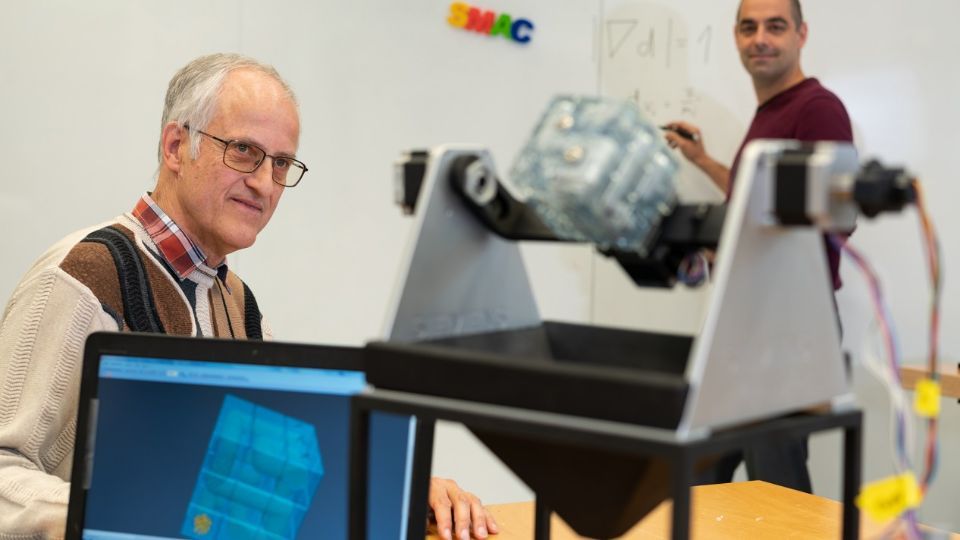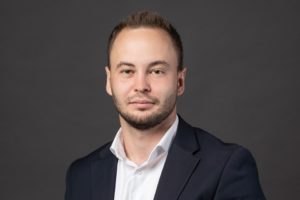A passion for digital twins

When Christoph Kiener asked the simulation experts at Siemens Corporate Technology to help him find a solution for shaking metal powder out of internal channels and cavities, an idea instantly popped into Dirk Hartmann’s mind. “I immediately thought of our crowd-flow simulation, Crowd Control, which we’ve been using to plan emergency escape routes in many different buildings over the past few years,” says Hartmann, a real-time simulation expert. “The two tasks are so similar that it made perfect sense to use the same mathematics and procedure. People in the emergency escape simulation who traverse hallways and staircases to reach exits are equivalent to the powder particles in Kiener’s de-powdering challenge that need to traverse the internal channels and cavities and trickle out.”
Proven success
Kiener, who works on advancing 3D printing innovations at Corporate Technology, recalls how relieved he was that Hartmann and his colleague Meinhard Paffrath had the experience with Crowd Control that enabled them to present a preliminary feasibility sketch after just a few days. “I knew then that it was possible to build an automated cleaning machine that could remove the metal powder left in the cavities of additively manufactured components using simulation-controlled rotating and shaking motions.” Kiener’s confidence was well-placed. Less than a year later, he’d not only implemented a prototype of the automated cleaning machine with machine-builder Solukon, he’d also presented it at the leading trade show for additive manufacturing, Formnext 2018, where it was a tremendous success.
Faster start
“Naturally, it takes much less time to arrive at a solution if you can rely on prior knowledge,” emphasizes Hartmann. “If you have to start from zero, you lack not only the mathematics and procedure but also the practical experience from previous applications.” “Nevertheless, it was a challenge for us,” affirms Paffrath, “especially in terms of the simulation speed.” No real-time simulation is required for calculating the rotating and shaking motions. This can easily be done beforehand, but it shouldn’t take days to accomplish. “In this case as well, our valuable prior knowledge helped us speed up the search for a solution,” says Paffrath. “Colleagues from Siemens PLM Software provided us with their high-precision particle simulations from the Simcenter simulation and test suite. These were the perfect starting point for quickly developing our own solution, which is based on controlled deviations in simulation accuracy – a solution that was streamlined enough to deliver the necessary simulation speed.”
World-class expertise
It isn’t unusual for Hartmann and Paffrath to be able to start developing a solution concept as soon as they receive a request. “Siemens has long maintained strong research in simulation innovation,” explains Virginie Maillard, head of the Simulation and Digital Twin Technology Field at Corporate Technology. “We not only have 130 experts on hand with a great deal of knowledge and experience, we also have a rich and varied treasure-trove of solutions and tools that also include new developments like virtual reality and artificial intelligence.” That’s why Paffrath has no problem citing other project successes, including virtual real-time forecasting of the internal temperature of electric motors that was developed three years ago by Utz Wever, another colleague of Hartmann and Paffrath.
Virtual forecasting
Wever’s real-time forecasting was in response to a request from Siemens Large Drives Applications. The research and development department there was looking for a solution that would precisely calculate the amount of time that large electric motors need to cool between stopping and restarting, instead of having to work with estimates because the temperature in the motor’s inaccessible interior can’t actually be measured. Wever’s solution now provides a tool that allows real-time forecasts of what the temperature progression inside the motor would be if it were restarted at any specific point in time. This information now makes it possible to restart large motors sooner than in the past, with the result that they’re better utilized.
Advantage own research
“Among other things, we were able to take advantage of a procedural approach from the still-new research field of uncertainty quantification, which we’d already dealt with very early on in our own research,” explains Wever. “Several years before, we’d developed an optimization tool that allowed us to design products that were robust in terms of manufacturing and measurement tolerances. The procedural approach used for this tool systematically takes into account all potential errors and their effects on the end result, which makes it possible to deal with uncertainties. And this was exactly the approach needed to implement real time-capable, virtual temperature forecasts for electric motors.”
Fit for industry
“Without our own research, we’d first have had to look for experts in academic research who could supply us with the necessary knowledge,” says Maillard. “And that would not only have taken time, it would have brought up a brand-new set of problems. Unlike academic research facilities, we’re familiar with industrial requirements and have extensive experience with Siemens’ fields of business. This means we can quickly deliver industry-standard solutions and not just concepts.”
Copyright: siemens.com/stories














